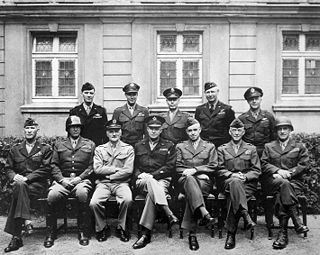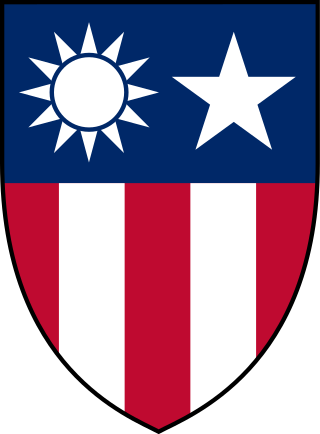
Joseph Warren "Vinegar Joe" Stilwell was a United States Army general who served in the China Burma India Theater during World War II. Stilwell was made the Chief of Staff of the Chinese Nationalist Leader, Chiang Kai-shek. He spent the majority of his tenure striving for a 90-division army trained by American troops and equipped with American lend-lease and fighting to reclaim Burma from the Japanese. His efforts led to friction with Chiang who viewed troops not under his immediate control as a threat and who saw the Chinese communists as a greater rival than Japan. An early American popular hero of the war for leading a column walking out of Burma pursued by the victorious Imperial Japanese Armed Forces, his implacable demands for units debilitated by disease to be sent into heavy combat resulted in Merrill's Marauders becoming disenchanted with him. The U.S. government was infuriated by the 1944 fall of Changsha to a Japanese offensive. Stilwell delivered a message to the Chinese Nationalist leader, Chiang Kai-shek from President Roosevelt that threatened that lend-lease aid to China would be cut off. The resulting friction atop an already tense relationship made Ambassador Patrick J. Hurley advocate that Stilwell had to be replaced. Chiang had been intent on keeping Lend-Lease supplies to fight the Chinese Communist Party, but Stilwell had been obeying his instructions to get the Communists and the Nationalists to co-operate against Japan.

The European Theater of Operations, United States Army (ETOUSA) was a theater of Operations responsible for directing United States Army operations throughout the European theatre of World War II, from 1942 to 1945. It commanded Army Ground Forces (AGF), United States Army Air Forces (USAAF), and Army Service Forces (ASF) operations north of Italy and the Mediterranean coast. It was bordered to the south by the North African Theater of Operations, United States Army (NATOUSA), which later became the Mediterranean Theater of Operations, United States Army (MTOUSA).

Sun Li-jen was a Chinese Nationalist (KMT) general, a graduate of Virginia Military Institute in the United States, best known for his leadership in the Second Sino-Japanese War and the Chinese Civil War. His military achievements earned him the laudatory nickname "Rommel of the East". His New First Army was known as the "Best Army under heaven" and credited with effectively confronting Japanese troops in the 1937 Battle of Shanghai and in the Burma Campaign, 1943–1944.

The New 1st Army was reputed to be the most elite military unit of the Chinese National Revolutionary Army. Nicknamed the "First Army Under Heaven" during the Chinese Civil War, it caused the most Japanese Army casualties during the Sino-Japanese War (1937-1945).

The Fourteenth Air Force was a numbered air force of the United States Air Force Space Command (AFSPC). It was headquartered at Vandenberg Air Force Base, California.
An army group is a military organization consisting of several field armies, which is self-sufficient for indefinite periods. It is usually responsible for a particular geographic area. An army group is the largest field organization handled by a single commander – usually a full general or field marshal – and it generally includes between 400,000 and 1,000,000 soldiers.

The Northern Combat Area Command (NCAC) was a subcommand of the Allied South East Asia Command (SEAC) during World War II. It controlled Allied ground operations in northern Burma. For most of its existence, NCAC was commanded by United States Army General Joseph "Vinegar Joe" Stilwell. In 1945 after Stilwell was recalled, his deputy, Lieutenant General Daniel Sultan, was promoted to and assumed command.

The Burma campaign was a series of battles fought in the British colony of Burma. It was part of the South-East Asian theatre of World War II and primarily involved forces of the Allies against the invading forces of the Empire of Japan. Imperial Japan was supported by the Thai Phayap Army, as well as two collaborationist independence movements and armies. Nominally independent puppet states were established in the conquered areas and some territories were annexed by Thailand. In 1942 and 1943, the international Allied force in British India launched several failed offensives to retake lost territories. Fighting intensified in 1944, and British Empire forces peaked at around 1 million land and air forces. These forces were drawn primarily from British India, with British Army forces, 100,000 East and West African colonial troops, and smaller numbers of land and air forces from several other Dominions and Colonies. These additional forces allowed the Allied recapture of Burma in 1945.

China Burma India Theater (CBI) was the United States military designation during World War II for the China and Southeast Asian or India–Burma (IBT) theaters. Operational command of Allied forces in the CBI was officially the responsibility of the Supreme Commanders for South East Asia or China. In practice, U.S. forces were usually overseen by General Joseph Stilwell, the Deputy Allied Commander in China; the term "CBI" was significant in logistical, material and personnel matters; it was and is commonly used within the US for these theaters.

X Force was the name given to the portion of the National Revolutionary Army's Chinese Expeditionary Force that retreated from Burma into British India in 1942. Chiang Kai-shek sent troops into Burma from Yunnan in 1942 to assist the British in holding back the Japanese. These Chinese forces became broken up, and in the retreat out of Burma part of these forces entered India. These were cantoned at Ramgarh Cantonment in the Bihar Province, brought up to five-Division strength, and re-equipped and re-trained by American instructors at British expense.
The Battle of West Hunan, also known as the Battle of Xuefeng Mountains and the Zhijiang Campaign, was the Japanese invasion of west Hunan and the subsequent Allied counterattack that occurred between 6 April and 7 June 1945, during the last months of the Second Sino-Japanese War. Japanese strategic aims for this campaign were to seize Chinese airfields and secure railroads in West Hunan, and to achieve a decisive victory that their depleted land forces needed.
Longhai Campaign (陇海战役), also known as the Campaign along the Longhai Railway (陇海路战役), was a campaign launched against the nationalists by the communists during Chinese Civil War in the post World War II era. The campaign was a coordinated offensive in support of the other two campaigns the Communists launched against the nationalists, namely, the Campaign of the North China Plain Pocket and the Central Jiangsu Campaign. Longhai Campaign resulted in the communist victory, achieving the Communists objective of relieving the pressure on their comrades in the other two campaigns this one supported, enabling those in the Campaign of the North China Plain Pocket to successfully escape from the nationalists and those in the Central Jiangsu Campaign to also score a huge victory over the nationalists.

The Menglianggu campaign was fought between the nationalists and the communists during the Chinese Civil War in the post-World War II era and resulted in communist victory. The campaign was later used by the communists as a specific battle example in their military science and history, as well as a propaganda piece. The battle mainly took place in Menglianggu of Linyi region in Shandong Province.

Li Mi was a high-ranking Nationalist general who participated in the anti-Communist Encirclement Campaigns, Second Sino-Japanese War and Chinese Civil War. He was one of the few Kuomintang commanders to achieve notable victories against both Chinese Communist forces and the Imperial Japanese Army. Following the founding of the People's Republic of China in 1949, he withdrew his forces to Burma and Thailand, where he continued to carry out guerrilla raids into Communist-held territory.

This is a list of United States Army Air Forces Consolidated B-24 Liberator units and formations during World War II including variants and other historical information. Heavy bomber training organizations primarily under II Bomber Command in the United States and non-combat units are not included.

The 71st Group Army, Unit 31655, formerly the 12th Group Army, is a formation of the Chinese People's Liberation Army Ground Forces (PLAGF). The 71st Group Army, is one of thirteen total group armies of the PLAGF, the largest echelon of ground forces in the People's Republic of China. Assigned to the nation's Eastern Theater Command, the primary mission of the 71st Group Army is likely preparation for conflict in or about the Taiwan Strait. The unit is headquartered in Xuzhou City, Jiangsu Province.

The 74th Group Army, Unit 31661, formerly the 42nd Group Army, is a military formation of the Chinese People's Liberation Army Ground Forces (PLAGF). The 74th Group Army is one of thirteen total group armies of the PLAGF, the largest echelon of ground forces in the People's Republic of China, and one of two assigned to the nation's Southern Theater Command.
Gordon Stifler Seagrave was a Burmese-born American missionary, physician and author.
Paul Lional Edward Helliwell was an American lawyer, banker, OSS official, and CIA officer. While serving in this capacity he became director of Sea Supply, Inc. and president of Castle Bank & Trust. Helliwell was instrumental in setting up Civil Air Transport and Castle Bank & Trust, both of which were CIA proprietary companies. According to The Wall Street Journal, he was "deeply involved" in financing covert actions against Cuba from 1964 to 1975. Helliwell was reported to have played a key role in the purchase of the site for Disney World.

The 87th Division was a German-trained and reorganized division in the Republic of China's National Revolutionary Army, which was active during the Second Sino-Japanese War. As one of Chiang Kai-shek's elite divisions that received training from German instructors as part of a program of reorganizing the Chinese army, it and its sister 88th Division were regarded as the Chinese Nationalist government's best units. The 87th Division notable for taking part in the Battle of Shanghai in the summer and fall of 1937. Prior to that it had fought in Shanghai against the Japanese during the January 28 Incident in 1932, and following the second engagement in 1937 the division saw action during the Battle of Nanjing and the Burma Campaign. After Japan's surrender, the 87th Division then fought in the Chinese Civil War against the Communists and was dissolved after the conflict.













